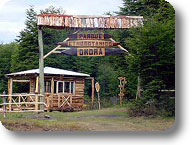
 |
Omora Ethnobotanical Park |
Protected Area |
|
|
|
Omora Ethnobotanical Park |
|

|
The Omora Ethnobotanical Park is a collaborative initiative between the Omora NGO and the Universidad de Magallanes and is a party to BGCI’s International Agenda for Botanical Gardens in Conservation.
The Park is located 3 km west of Puerto Williams on the north coast of Isla Navarino. Within the park interpretative trails explore most of the major habitat types of the region: coastal coigue forests, lenga parks, ñirre forests, Sphagnum bogs, beaver wetlands and alpine heath. In addition, the Robalo River runs through the park and provides potable water to the town of Puerto Williams. The Omora Park aspires to be:
|
The Omora Foundation |
|

|
The Omora Foundation is a Chilean non-governmental organization (NGO) dedicated to biocultural conservation in the extreme southern tip of South America. The Foundation receives its name from the Yahgan word for “hummingbird.” However, in the Yahgan cosmology Omora was more than a bird; he was also a revered hero. In ancestral times, when humans and other animals lived in the same society, little Omora would arrive to settle ecological and personal disputes and in that way he maintained the harmony of society and nature. The holistic meaning of Omora bridges the divide between humans and other living beings, between society and the natural environment. The Omora Foundation attempts to embody this last, broader definition in its mission to “integrate biocultural conservation with social well being at the ends of the Earth.” |
Ethnobotany |
|
| The Omora Park is also member of the Latin American Network of Ethnobotanical Sister Gardens. Ethnobotany is the study and practice of the relationship between humans, plants and the ecosystem inhabited by them. In the spirit of ethnobotany, Omora promotes conservation of the traditional ecological knowledge held by diverse ethnic groups, particularly the Yahgans. As part of the park’s intercultural education program, the signs identifying the various plants and animals include the names in Yahgan, scientific Latin, English and Spanish for each species. For example, the bush upush, Ribes magellanicum or zarzaparrilla, possesses names which express diverse cultural points of view about this species. In Yahgan, Puerto Williams was called Upushwaia, because it was the bay (waia) where upush was abundant. For scientists it is a species of the genus Ribes (blackberries and currants), which is exclusive to the region of Magallanes, hence the Latin name: Ribes magellanicum. The Spanish conquistadors observed that this bush grew everywhere, much like a weed or zarza, and its leaves reminded them of the grapevine or parra; hence, zarza-parrilla. |
|
Conservation and Investigation |
|
| The Omora Foundation has focused its conservation efforts on the maintenance and monitoring of the Omora Ethnobotanical Park, an area of 400 hectares just outside of Pto. Williams on Navarino Island. The Park comprises all of the 13 habitat types that can be encountered on the islands south of Tierra del Fuego from different coastlines through the various forest types, shrub- and moorlands, all the way up to the alpine zone. Hence Omora is conserving a complete mosaic of the sub-antarctic ecosystem. Furthermore, the Omora Park protects the watershed of the Robalo River, the principal source of drinking water for Puerto Williams. A further conservation effort focuses specifically on the control of invasive exotic fauna on Navarino Island. Since 2003, Omora has collaborated with the Chilean national service for agriculture and livestock (Servicio Agricola y Ganadero - SAG) with the aim of controlling the reproduction of beaver (Castor canadensis) and mink (Mustela vison). The beaver has heavily impacted the forested regions of the island, while the mink threatens to decimate native rodent and bird populations. A significant contribution to conservation efforts in general is the co-edition of the Latin American version of Richard Primack's "Essentials of Conservation Biology" called "Fundamentos de Conservación Biológica - Perspectivas Latinoamericanas" in 2001. Ricardo Rozzi and Francisca Massardo contributed to its content and to the practical realisation of this large project. In concordance with Omora’s ambition to promote biocultural conservation, biological studies in the park are seen in relation with expressions of the Yahgan cosmology. This not only enriches the common understanding about ecological processes but also contributes to the rescue of remnants of the Yahgan culture and knowledge, especially concerning the forests. One possible result will be the assemblage of a Yahgan Natural History. Moreover, The Omora Foundation participates in several investigation projects, among which The Miniature Forests of Cape Horn: Darwin Initiative (2004 - present), and Forest Birds of the Magallanes Region (1999 - present). |